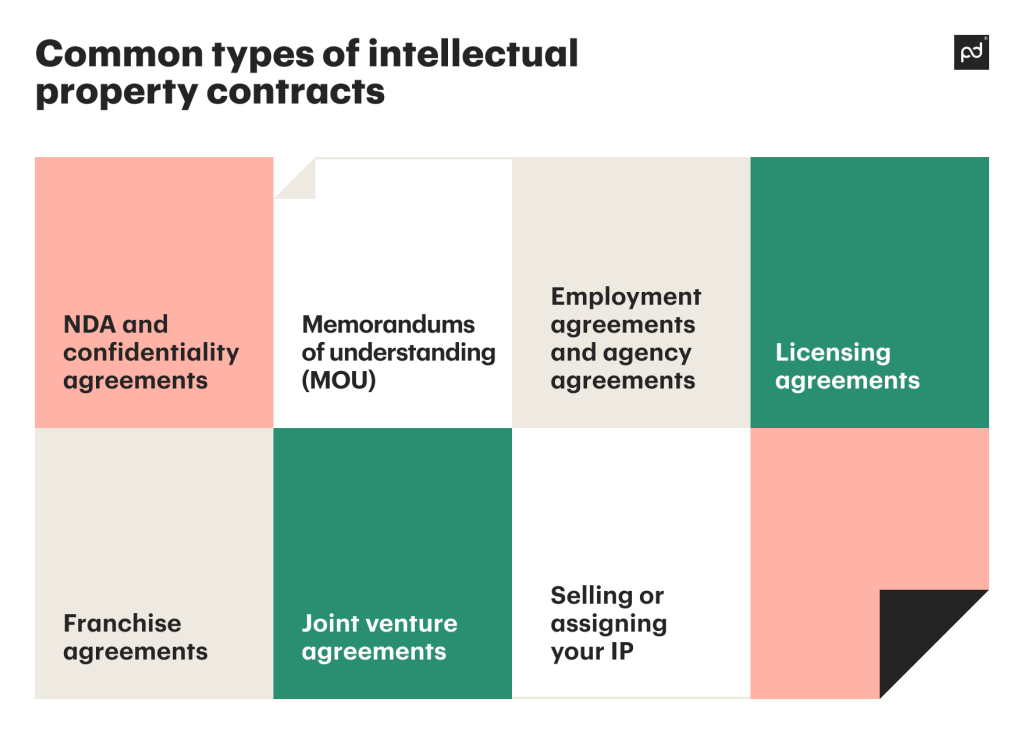
If you run a business, you are likely to own intellectual property or use the IP of other companies for your business needs.
If so, you must be aware of how vital it is to protect intellectual property in order to avoid leaking or copying sensitive and valuable IP data.
The typical way of doing so is to register trademarks, patents, or copyrights. However, there is another and more practical way for businesses: by signing intellectual property contracts.
Those include contracts you’re likely familiar with — employee agreements, non-disclosure agreements, licensee agreements, and others.
At PandaDoc, we are eager to help you create better contracts. This article will explain why contracts are so essential for protecting your intellectual property.
Let’s take a second to define what intellectual property actually is.
Intellectual property is a term used for a set of intangible assets owned by a person or a company. It includes ideas, concepts, or products that are not physical in nature.
There are many intangible assets different for each country, with trademarks, patents, and copyrights among the best-known ones.
The World Intellectual Property Organization (WIPO) refers to intellectual property as “creations of the mind, such as inventions; literary and artistic works; designs; and symbols, names, and images used in commerce.”
For businesses, it can mean a company’s name, logo, slogan, software, or business processes.
It could be everything that defines you as a brand and helps you to stand out among competitors.
Intellectual property is a source of revenue. For example, an IP owner can give others the right to use an intellectual property asset in exchange for a specific fee.
IP can be sold, used to create a new business, integrated with other, existing IP, or contributed to a joint venture.
Clearly, for many businesses intellectual property is much more valuable than intangible assets.
The IP Commission Report, first published in 2013 and then updated in 2017, estimates that IP theft costs U.S. companies as much as $600 billion annually.

People and companies you intend to work with will use your intellectual property to different degrees, so be sure to add intellectual property-related clauses in contracts you are about to sign.
Or, in the case of existing business collaborations, signing additional agreements helps ensure you protect your intellectual property throughout the duration of the working relationship.
A rule to keep in mind when doing business that involves your intellectual property is the following: Always use written agreements and make sure that, where relevant, your IP is covered in these contracts.
An intellectual property contract is an agreement between two parties that defines terms and conditions for intellectual property.
Most IP contracts include a license in their terms. It authorizes another party to perform specific tasks using intellectual property.
For example, an NDA can allow a third party to discuss trade secrets internally to work on a particular job.
There are four key reasons to choose intellectual property agreements for IP protection.
An IP agreement clearly states who owns the intellectual property. In business, the ownership usually belongs to companies (even if, technically, it’s likely that employees were the ones that created the IP).
Clearly defined intellectual property ownership facilitates optimal relations with your partners and employees and saves you time on legal disputes.
Each country has its own intellectual property rights; be sure to familiarize yourself with domestic laws before opening up a business in a new location.
When you sign a contract with your employees and partners, you ensure certain safeguards related to IP access.
Should any entity breach the contract at any time, they will incur the consequences stated in your agreement.
Your employees, partners, or competitors can’t use or distribute your assets unless you grant them an IP license.
It defines your uniqueness in the market and differentiates you from businesses similar to yours.
Creating IP-related contracts is not novel — you have probably signed or familiarized yourself with these contracts before.
You might consider using contract management software to manage agreements faster and more efficiently.
No matter what you do — whether you use a contract management system, contract templates, or create contracts on your own — you should know what types of IP contracts exist and when to use them.

Non-disclosure and confidentiality agreements ensure that sensitive information concerning IP is kept confidential.
Typical examples include trade secrets, business plans, company structures, financial and accounting information, technologies, or codes.
An NDA or confidentiality agreement protects your IP from being leaked or shared with potential competitors.
Make sure you have an agreement ready during the hiring and onboarding process.
Sign agreements with your investors to protect confidentiality in disclosure.
Even if you’re in the research and development stage or going through mergers, acquisitions, or a company’s sales record — these are important reasons to sign an NDA or confidentiality agreement.
Although an MOU is not a legally binding contract, it is a crucial document in business transactions.
Typically a memorandum of understanding agreement serves as a pre-step to entering into a more complex agreement; for example, a franchising contract.
The goal of an MOU is to ensure that the parties are “on the same page.” It is widely used to facilitate a partnership between two companies which oftentimes involves the use of the intellectual property.
When drafting a memorandum of understanding, add a clause about intellectual property, state its definition and define the ownership.
Consider drafting an NDA or confidentiality contract in addition to the MOU to add one more level of security to protect your intellectual property.
In most business cases, employees create or contribute to intellectual property.
Agencies do similar things — they are employed to provide services for a company that owns IP.
When signing an employment or agency agreement, ensure you have a clause about intellectual property. Cover that your company owns the IP.
It will help you avoid legal battles with employees that often happen because of no clarity regarding who owns what.
If your business is in the R&D stage, specify who owns the old IP (created before the date of agreement) and the new IP (created during employment).
It is a common practice to ask an employee to sign a confidentiality agreement or acknowledgment of ownership form. The latter states that all materials should be handed to a company after employment ends.
The same rules exist for agencies. Agency employees act in their employer’s best interests, which means they are likely to contribute to your intellectual property.
The rule stays the same: make sure you add a clause about IP ownership in an agency agreement.
A licensing agreement allows a licensee to use intellectual property owned by a licensor for the former’s business operations.
There are two types of licenses — exclusive and nonexclusive, also known as limited and unlimited.
An exclusive license means that a licensee is the only entity authorized to use intellectual property — software, product, or content — during the length of a contract.
A nonexclusive license allows different people to use IP simultaneously.
A simple example would be how the Mozilla web browser Firefox is used by millions of people who, among other things, can contribute to its development by adding new code or plugins.
Most license agreements have a clause on royalties. Those are usage-based payments made by a licensee to a licensor for the use of IP.
Note that royalties are not the same as licensing fees. The last is generally a fixed price paid to a licensor for IP usage.
A franchise agreement is a contract between a franchisor and a franchisee.
The franchisor is usually a company or a person with a successful brand and know-how.
They give a franchisee the right to replicate the franchisor’s business model for a particular time and location in exchange for a fee.
In that way, a franchisee can improve their own business and benefit from training and ongoing support from the franchisor.
Intellectual property can be an aspect of a franchise agreement in two ways:
Usually, franchise agreements have a clause on licensing IP to the franchisee. It is vital to draft it thoroughly and cover relevant use cases.
It’s an important step since there are cases when companies open new businesses after the end of the agreement and use the knowledge gained during the partnership.
A joint venture agreement is a contract between two companies entering a temporary business relationship. The purpose may be to create a new product or to perform any business activity.
This agreement is appropriate when each party decides to share one IP to perform an activity together. Or to use it to create a new intellectual property.
It’s crucial to cover which party brings the IP to a joint venture agreement. And if both parties create a new IP, state who will own it at the end of the partnership.
Sales agreements or assignment agreements differ from a license because they involve an actual sale or assignment of IP.
In this process, the owner is giving up the ownership rights and is selling them to another party.
From that moment, a new owner has the right to use or license IP assets.
It’s a good practice for a buyer to request information on licenses or charges over IP, as they may inherit them after purchase.
And it’s better to be aware of what you’ll be responsible for after successfully completing a purchase.
Familiarizing yourself with the list of IP contract types is half of the deal.
You should know what to include in an agreement to ensure you protect your IP through and through.

When defining intellectual property in a contract, keep your definition as broad as possible.
For example, limiting the definition to a registered IP gives a party the right to share trade secrets, know-how, and confidential information.
Keep in mind that contracts may be geographically restricted. So if your agreement is limited to a specific country, include a definition of intellectual property that applies in that particular place.
State the ownership of intellectual property that is used or developed throughout the relationship with your employee or partner.
This makes it clear that when employees leave a job after creating IP and believe they can take intellectual property rights with them — it’s not going to happen.
The fact that they created IP during employment does not give employees the right to own it.
A contract must specify who is authorized to access intellectual property, when and for how long.
Some businesses even run non-compete agreements to prevent employees from working in a related area for a specified time after they leave a company.
As this type of agreement is limited, you can devise other ways to protect data — for example, setting up access to information through a secure server or database.
The confidentiality clause is the most vital part of any agreement related to IP.
Due to a high competition and innovation boom, companies should be proactive and care about security measures.
Any contract should emphasize a duty to maintain confidential information and provide clear statements on consequences for failure to comply with them.
Be explicit when specifying the consequences of breaching a contract. It will not work in your favor if you use vague descriptions about fines, penalties, or litigation.
Third-parties signing an agreement should clearly understand that the company takes security very critically and will use any legal remedies possible.
It should help employees to stay cautious and make them follow security policies.
An indemnity obligates one party to compensate the other for damages.
IP-related indemnification clauses can be overlooked in contracts, raising the problem of claiming something back. Make sure it does not happen with your agreement.
Always address the scope and the period of indemnity in your contract.
Creating a contract is always challenging. A single phrase or clarity issue could cause legal disputes.
Consider using our contract management software to facilitate your work when creating contracts.
PandaDoc’s contract management system includes a library of contract templates pre-filled with relevant clause choices.
Customize them, create new clauses, and get error-free contracts to sign with your partners and employees.
Store and organize arrangements in one convenient space and easily navigate between them.
With PandaDoc’s solution, you can integrate CRM and pull customer data into your documents in a few clicks — no need to do it manually ever again!
PandDoc is not a law firm, or a substitute for an attorney or law firm. This page is not intended to and does not provide legal advice. Should you have legal questions on the validity of e-signatures or digital signatures and the enforceability thereof, please consult with an attorney or law firm. Use of PandaDocs services are governed by our Terms of Use and Privacy Policy.
Include clauses in your contracts related to existing or future intellectual property and indicate who holds the ownership rights. Define the duration of IP licenses and specify in what country or region the licensed rights apply.
The main purpose of intellectual property is to encourage people to make new creations and, by that, stimulate overall economic growth. It is achieved through the legal protection that intellectual property provides to the creators of original works.
When employees and partners sign a contract, it means they agree with terms and conditions with respect to the intellectual property. Their signatures give everyone involved legal protection in case of a breach of contract.
Intellectual property means creations of the human mind, such as ideas and concepts. Any physical property, such as real estate, jewelry, fashion, cars, etc., can’t be considered intellectual property or protected.
Olga Asheychik Senior Web Analytics Manager at PandaDoc
Olga is a Senior Web Analytics Manager at PandaDoc who has been working in the Digital Marketing field for the past 15 years. Olga had roles driving marketing campaigns in document automation, contracts, invoices, and agreements. In her daily life, she is a big fan of traveling and connecting with new people.



Subscribe to get our most-popular proposal eBook and more top revenue content to help you send docs faster.